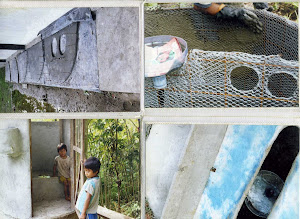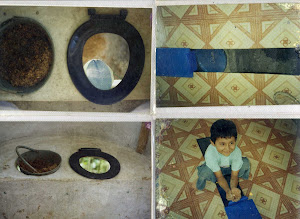(see below for English)
Wildlife Conservation Society (WCS, del Zoológico de Nueva York), el Ecofondo (del Ecuador), y la comunidad Kichwa de Nueva Providencia, con la participación de otras entidades, están terminando de construir el Centro de Interpretación sobre Animales Acuáticos "Yaku Causai". En este hermoso lugar, dentro del bosque y con construcciones en materiales naturales de la selva, van a invitar a turistas y estudiantes nacionales e internacionales a conocer más sobre los animales que habitan el agua, por medio de observación de esculturas en balsa a tamaño real y otras actividades. Los delfines, nutrias, manatíes, caimanes, anacondas, paiches, bagres y otros animales que viven en las aguas del Parque Nacional Yasuní son sumamente interesantes, pero también muy difíciles de ver en su hábitat natural.
Han tomado la muy acertada decisión de evitar la contaminación del hábitat acuático de estos animales y, más bien, construir un Inodoro Ecológico Seco para que los visitantes puedan hacer sus necesidades biológicas.
Este modelo es interesante por ser, a la vez, minimalista y elegante. Tiene simplemente una banca para sentarse y, debajo de ésta, habrá una caja ventilada donde se colocan un embudo para colectar la orina y un saquillo para colectar las heces (junto con un material secante). Todas las superficies donde el usuario va a pisar o sentarse están cubiertas con hermosas cerámicas que son lisas y fáciles de limpiar. El resto de la estructura será de nobles materiales naturales: hojas de palma para el techo y paredes para privacidad de la madera de otra especie de palma.
Cuando el saquillo comienza a llenarse o a presentarse algún problema de moscas u olores, se le cierra y se coloca otro. El saco lleno es almacenado durante por lo menos 6 meses debajo de un pequeño techo de plástico en el bosque, para que se mueran todos los organismos de enfermedades. Como esto ocurre en la sombra del bosque, los rayos ultravioletas no dañan ni el techo de plástico ni el saquillo de plástico.
En la colección de la orina, también hubo algo de innovación. El embudo (hecho de una botella de 4 litros, como se ve en otras entradas de este blog) desemboca en un codo y tubo de PVC de 2 pulgadas. De esta manera, el embudo es puesto simplemente a presión y es fácilmente removido para la debida limpieza y mantenimiento. Este tubo de 150 cm sale horizontalmente de la estructura, con una pendiente adecuada, donde es conectado a la manguera perforada de 15 metros para la distribución de la orina en el suelo, entre las plantas.
Debajo de la banca, se va construir una caja lo más herméticamente posible, pero con el tubo de ventilación de 16 cm de diámetro por 3 m de largo, de tal manera que el aire debe solamente entrar en el asiento del inodoro y salir por esta chimenea. Encima, tiene puesto una malla metálica para prevenir el ingreso de insectos, pero no tiene un techo para prevenir el ingreso de lluvia, de tal manera que tampoco impide el flujo de aire. Otro embudo está colocado en el suelo, debajo de este tubo, para eliminar esta agua de lluvia, que de paso va contribuir a la remoción de telas de araña y la limpieza del aire. El tubo tiene dos faldas de caucho de tubo de llanta de camión, para empatar bien con el techo de hojas de palma y prevenir las goteras. La punta del tubo de ventilación está cortada en un fuerte ángulo (32 cm abajo en otro lado) para generar más flujo del aire. La caja inferior va tener una puerta en la parte de atrás, desde la banca hasta el suelo, para poder cambiar los sacos y realizar cualquier mantenimiento. Las cuatro esquinas del saco serán templadas con ganchos a los finales de cuerdas, mientras el suelo aguanta su peso.
La mayor parte de la construcción hicimos en un solo día, con la participación de unas 7 personas. Solo quedó para hacer (después de endurecerse el cemento) la construcción de la caja mencionada, las paredes de privacidad, la puerta, la colocación del embudo y del saquillo. Es de 100 x 150 cm, con la separación del piso y la banca en la mitad, a los 75 cm, los mismos que están hechos en ferrocemento con cerámicas puestas directamente en el cemento fresco.
En las fotos, no se ve todavía la caja hermética, porque recién se había fundado el cemento y necesitaba por lo menos una semana para endurecerse, antes de estar martillando alrededor. En aquel momento, se va a retirar el encofrado de tablas de debajo de la banca, dejando abierto el hueco rectangular y se sacarán los palitos que formaron los huecos para los pernos del asiento convencional de plástico. Una de las fotos es del embudo para sacar el agua que caerá por el tubo de ventilación, con una malla plástica para prevenir que vayan basuras, y al final del tubo hay una malla plástica para prevenir la entrada de insectos y una manga de plástico flexible para prevenir la entrada de aire. Se aplicará aceite en la madera del poste y una capa de plástico para protegerle del agua.
- - - English Version - - -
Wildlife Conservation Society (of the New York Zoo), the "Ecofondo" (of the Ecuadorian government), and the Kichwa community of Nueva Providencia, with the participation of other entities, is finishing the building of the "Yaku Causai" Interpretation Center for explaining about aquatic animals. In this beautiful place, in the forest and with constructions made from natural jungle materials, they will invite Ecuadorian and foreign tourists and students to learn more about the animals that live under the water, via observation of life-sized balsa wood sculptures and other activities. The dolphins, otters, manatees, cayman, anacondas, catfish and other animals that live in the waters of Yasuní National Park are very interesting, but very hard to see in their natural habitat.
They made the great decision to avoid contaminating the aquatic habitat of these animals and instead build an Ecological Dry Toilet, where visitors can attend to their biological needs.
The model we built is interesting as it is, at the same time, minimalist and elegant. It simply has a bench to sit on and under it there is a ventilated box where the funnel to collect urine and a rice sack to collect feces will be placed. (Ample dry organic material will be added to cover each deposit of feces.) All of the surfaces where the user will step or sit are covered in fine ceramic tiles that are smooth and easy to clean. The rest of the structure will be made of strong palm wood and palm leaves.
When the sack is beginning to fill or present any problems of flies or smells, it is closed and replaced by another. Full sacks will be stored for six months under a plastic tarp in the forest, during which time all potential disease organisms die and the material converts to soil. As this occurs in the shade of the forest, ultraviolet rays destroy neither the plastic roof nor the plastic sacks.
In the collection of urine, there was also a bit of innovation. The funnel (made from a one-gallon plastic bottle, as can be seen in other entries of this blog) flows into an elbow and a pipe of 2-inch PVC. In this way, the funnel snaps into place and is easily removed for its proper cleaning and maintenance. The 150-cm pipe extends horizontally out of the structure, with an adequate slope, where it is connected to a 15-meter perforated hose to distribute the urine out among the plants on the soil.
Under the bench, a box will be built as air-tight as possible, but with vent pipe (16 cm diameter, 3 meters long) placed in such a way that air should only flow into the toilet and then out this chimney. The top end of this pipe is covered in metal screen to prevent the entry of insects, but it does not have roof to prevent the entry of rain, as that would impede the flow of air. Instead, a funnel was placed in the soil under this chimney to expel the rainwater as it falls through the structure (and in passing cleanses the air and the spider webs). The vent pipe has two skirts of truck inner-tube rubber, to connect well with the thatched roof and avoid drips. The top of the vent pipe was cut in a sharp angle (reaching 32 cm down on one side) to generate more air flow. The box underneath will have a door on the back, from the bench to the soil, for changing sacks for doing maintenance. The four corners of the sack will be held with hooks on strings, while its weight is simply supported by the soil.
Most of the construction was done in just one day, with about 7 people participating. All that was left to do after the cements hardens was the construction of the box and the privacy walls and the placement of the funnel and sack. It is 100 x 150 cm, with the separation between the floor and the bench halfway along, at 75 cm. These were made of ferrocement with ceramic tiles placed straight into the fresh cement.
In the photos, the air-tight box is not there yet, as the cement was fresh and needed to harden for at least a week before hammering around it. In that moment, the planks under the bench will be removed, leaving open the rectangular "drop hole" and the sticks will be removed that formed the holes for the bolts of the standard plastic seat. One of the photos shows the funnel for eliminating the rainwater that falls down the chimney, with a plastic mesh to prevent plugging with garbage, and at the end of the pipe there is a plastic mesh to prevent the entry of insects and a sleeve of flexible plastic to prevent air from coming in. Oil and a layer of plastic will be applied to this post to protect it from the water.










